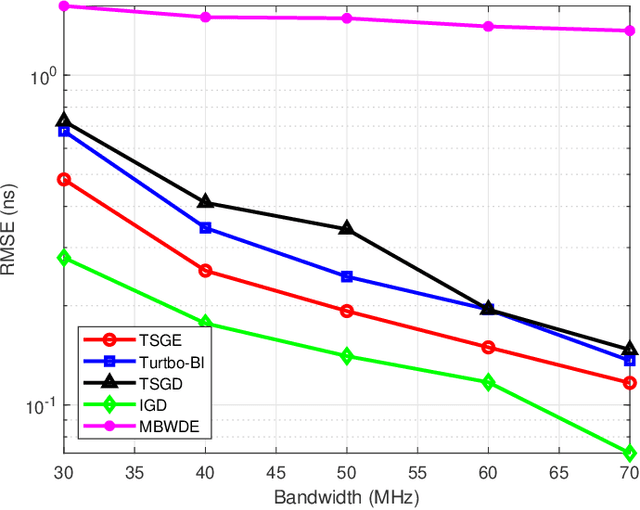Mianyi Zhang
Meta-Learning-Driven Adaptive Codebook Design for Near-Field Communications
Oct 10, 2024



Abstract:Extremely large-scale arrays (XL-arrays) and ultra-high frequencies are two key technologies for sixth-generation (6G) networks, offering higher system capacity and expanded bandwidth resources. To effectively combine these technologies, it is necessary to consider the near-field spherical-wave propagation model, rather than the traditional far-field planar-wave model. In this paper, we explore a near-field communication system comprising a base station (BS) with hybrid analog-digital beamforming and multiple mobile users. Our goal is to maximize the system's sum-rate by optimizing the near-field codebook design for hybrid precoding. To enable fast adaptation to varying user distributions, we propose a meta-learning-based framework that integrates the model-agnostic meta-learning (MAML) algorithm with a codebook learning network. Specifically, we first design a deep neural network (DNN) to learn the near-field codebook. Then, we combine the MAML algorithm with the DNN to allow rapid adaptation to different channel conditions by leveraging a well-initialized model from the outer network. Simulation results demonstrate that our proposed framework outperforms conventional algorithms, offering improved generalization and better overall performance.
Design and Performance Analysis of Wireless Legitimate Surveillance Systems with Radar Function
Feb 14, 2023



Abstract:Integrated sensing and communication (ISAC) has recently been considered as a promising approach to save spectrum resources and reduce hardware cost. Meanwhile, as information security becomes increasingly more critical issue, government agencies urgently need to legitimately monitor suspicious communications via proactive eavesdropping. Thus, in this paper, we investigate a wireless legitimate surveillance system with radar function. We seek to jointly optimize the receive and transmit beamforming vectors to maximize the eavesdropping success probability which is transformed into the difference of signal-to-interference-plus-noise ratios (SINRs) subject to the performance requirements of radar and surveillance. The formulated problem is challenging to solve. By employing the Rayleigh quotient and fully exploiting the structure of the problem, we apply the divide-and-conquer principle to divide the formulated problem into two subproblems for two different cases. For the first case, we aim at minimizing the total transmit power, and for the second case we focus on maximizing the jamming power. For both subproblems, with the aid of orthogonal decomposition, we obtain the optimal solution of the receive and transmit beamforming vectors in closed-form. Performance analysis and discussion of some insightful results are also carried out. Finally, extensive simulation results demonstrate the effectiveness of our proposed algorithm in terms of eavesdropping success probability.
Multiband Delay Estimation for Localization Using a Two-Stage Global Estimation Scheme
Jun 20, 2022



Abstract:The time of arrival (TOA)-based localization techniques, which need to estimate the delay of the line-of-sight (LoS) path, have been widely employed in location-aware networks. To achieve a high-accuracy delay estimation, a number of multiband-based algorithms have been proposed recently, which exploit the channel state information (CSI) measurements over multiple non-contiguous frequency bands. However, to the best of our knowledge, there still lacks an efficient scheme that fully exploits the multiband gains when the phase distortion factors caused by hardware imperfections are considered, due to that the associated multi-parameter estimation problem contains many local optimums and the existing algorithms can easily get stuck in a "bad" local optimum. To address these issues, we propose a novel two-stage global estimation (TSGE) scheme for multiband delay estimation. In the coarse stage, we exploit the group sparsity structure of the multiband channel and propose a Turbo Bayesian inference (Turbo-BI) algorithm to achieve a good initial delay estimation based on a coarse signal model, which is transformed from the original multiband signal model by absorbing the carrier frequency terms. The estimation problem derived from the coarse signal model contains less local optimums and thus a more stable estimation can be achieved than directly using the original signal model. Then in the refined stage, with the help of coarse estimation results to narrow down the search range, we perform a global delay estimation using a particle swarm optimization-least square (PSO-LS) algorithm based on a refined multiband signal model to exploit the multiband gains to further improve the estimation accuracy. Simulation results show that the proposed TSGE significantly outperforms the benchmarks with comparative computational complexity.
 Add to Chrome
Add to Chrome Add to Firefox
Add to Firefox Add to Edge
Add to Edge